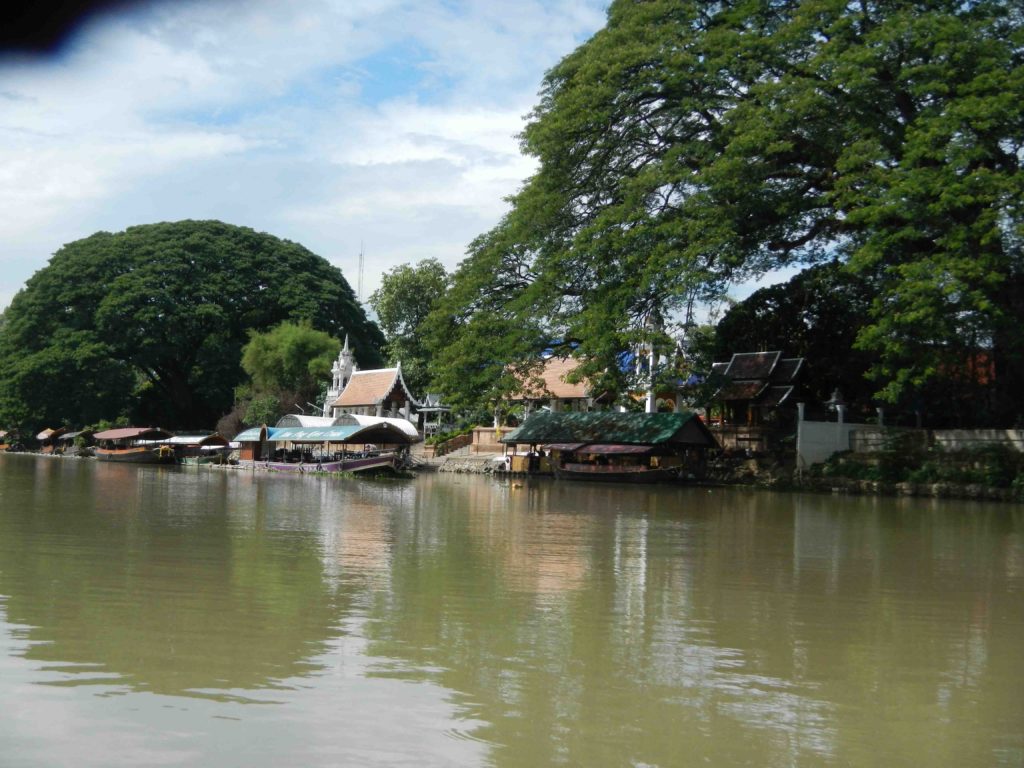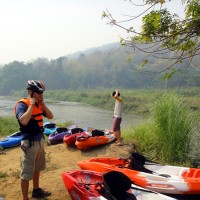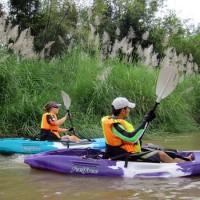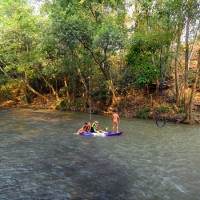The Northern Mae Ping River 2021
Join a rivers pace ….

100 km north of Chiang Mai, the Ping River comes to life as a navigable, clear green water creek and winds and twists itself through undisturbed woods and quiet farmland. Flocks of native and migrating birds, water buffaloes and other creatures, thirsty for the fresh and cool waters, will be accompanying the river’s journey. Here and there a bright blue plastic pipe sucking water, with a small motor grinding, promises irrigation.

We find the river lazily winding through farmland, nurturing the land around, but soon undisturbed, the river is swallowed up by the very same jungle that it is feeding with life – a thick cover of leaves brushing the water; fallen, uprooted trees and dams tell of flooding waters.
Here nature displays an order only a forest left untouched, in cycle with the seasonal rains, can create. The forest seems to try everything possible to claim and hold the water but the river finds its way through. Trees are so close together they seem to brace each other as the river carries their seeds downstream.

Thorny branches protecting their owner, bamboo branches holding their own, giant bees’ nests hanging low and a seemingly impenetrable undergrowth is keeping the casual visitor away. No motorboat ventures here in the shallow and unnavigable waters.
But there is man in the form of a hunter-gatherer, soundlessly gliding through the jungle, only picking what he needs. A happy smile holding the net. A gentle man who has learned to live side by side with life in the forest. Rewarded with a sharp mind and body he moves with the river. This man has inherited an ancient rhythm to live and let live and preserve his environment by adding no permanent structure and leaving no trace. This man does not seek power, this man does not thrive to control others. He eats, he sleeps, and tends to his gracious garden, the jungle. He adjusts to the seasons just like vines wither away in the dry season, leaving their host alive.

Living only a day, hundreds of yellow butterflies dance above the soft river sand in the sun's rays. Dragonflies are holding their positions while below ants are marching somewhere. Silently and with elegance a nearby python quietly crosses the river, her head up high, almost cheerful, enjoying the swim. A black bird with brown wings and red, piercing eyes is disturbed and seems to stumble through the air for another hiding place. An eagle is chased in the air by a smaller bird defending its territory. The frogs are making themselves known. The afternoon light filters bright green through thousands of bamboo leaves, home to a variety of harmless spiders, legs as thin as a man’s hair; they walk on water but would rather wait in their favorite trap structure. The deep, dark shade of a thick jungle makes a perfect afternoon for a group of fruit flies circling the ripe bounty of a tree. The river is peacefully immersed in the shrill, bright glitter of the reflecting afternoon sun. It is a forest rhythm.

Suddenly a nearby storm cloud is picking up the wind. The giant tower reaches up to 30,000 feet, ripe to unload and circulating fresh air to the forest’s surface. The sounds of creaking branches, millions of leaves waving in the wind, birds calling each other across the river signals a change. The sun for a moment seems more intense. The wind takes its last full breath, sending groups of fallen leaves down the river. It becomes still, only the cicada’s shrill call is heard. Everyone has taken cover. And then the first drop, a heavy drop, a drop that makes a difference, here to water the fertile land and join the current running south. The drops turn into streaks of plastering rain hitting the jungle canopy, a massive curtain of water descending onto the forest. It feels cooling, friendly, man breathes relief from the heat. The once-empty creek beds are now flowing vigorously with brown, soil-rich fresh water joining the speeding river.

At the height of the rainy season, massive water walls descend on this ecosystem as rains blanket the North of Thailand and Myanmar and there is a different feel. The red-brown water mass clears its way through the once dense path, branches near the water’s surface are stripped of their leaves, the river has swollen and claimed its seasonal might. A wider, determined, red-soil-carrying mass breaches the boundaries of its river banks. Everything must join the force of water. Large trees near the water’s edge are fighting the soil erosion with wave-like roots deflecting and supporting, but some have now fallen as the water relentlessly carves out its turns. Trees and debris of bamboo, branches, and plastic human waste is now floating downstream to its next resting places. Here it will remain for a new cycle of life.
The rain stops, coolness is replaced by the hot afternoon sun; life returns cautiously. The birds announce the all-clear with a bright blue kingfisher flying from branch to branch eyeing the water for prey. The leaves are shining, their wet glaze giving the jungle a fresh look.
Gradually the river has twisted itself out of the forest, its shores now starting to show signs of plantation life. The river reaches the first village, quickly makes a sharp left and is back in the forest again.
The presence of children, as the water nears the village, turns the river into twists of joy as the laughter of the youngsters echoes through the woods.

How much joy this water brings to the children – they can spend their entire day jumping in, floating downstream, zip-lining across, holding onto a moped tire at the end of a cable.
The river water is soil-enriched rain water. Fathers are teaching their children how to fish by spear. ‘You will never be hungry my son, the river provides.’ Women collecting mussels and a large variety of greens growing at its shores – the river provides. The flow has found its match: a bamboo dam is holding the eager water back, creating a deeper, calmer flow. Fish will spawn and grow here under the watchful eyes of the village elders. But nothing holds the water back for long – escaping in little streams twisting through the bamboo, the river continues its journey.
The river pleases the Buddhist monks; this region is peaceful and accessible. A few temples are nestled along the riverside, at a respectful distance so as not to become part of the river system itself. Cremation chapels along the way remind us that all flow will find its final destination.
The river slowly widens. Hills are filled with mango plantations. Each mango is wrapped individually with paper for protection while still hanging on the tree. Man is strong here, patient, old with youthful bodies, as the river provides.
Chiang Dao Valley
. In the near distance Chiang Dao mountain appears, From the river’s angle it appears like a shark fin piercing into the sky, towering above the rest of the range, “The last tooth of the Himalayas” remains visible from three sides as the river flows south.
The people of this valley seem particularly friendly, shaped by the hard work of farming blessed by the river. The river serves as the sole irrigation source for vast areas of farmland in the valley as it moves toward the Gap in the next mountain range south of the valley. This mountain group connects the farmland of the Chiang Dao Valley with further agriculture in the Mae Ngat Valley. In that Gap the river’s path narrows again, forcing the water to gain speed, and the dance with the foliage starts again.

Larger trees thrive in this riverscape; we can now also find large boulders speckled across the riverbed, creating some of the river’s few rapids. The water speed varies as the slope changes. As the riverbed has become wider, the water has more choices: forest debris and mountain contours are guiding the gravity-driven mass which simply just wants to go straight. The outside turns are well carved. Boulders create stationary, ever-circling eddies, allowing the water to drift upstream to rejoin the main current. The water knows its place: squeezed between rocks, it shapes itself into a group of tongues in the shape of upside-down triangles emptying into wave trails, forcing the slower water to reverse on its sides. Undulating roots at the river’s edge keep the tree stable, supporting its massive weight, gently deflecting the water, creating small eddies, keeping erosion at bay. The water flow is efficient: it maintains its travel plan and the casual observer finds this repetition soothing and reassuring. Abundant bird life fills the air with continuous wildlife communication – nothing remains unnoticed. As the river passes the only elephant camp on its shores, the silhouettes of free-roaming elephants join the shapes along the riverbank.

Mae Ngat Valley
The Valley widens. Man returns with bridges and dams, and there begins a relentless struggle with the river’s currents. Man is getting too close – development near the river has never-ending consequences. Only a man-made cement barricade could match the power of the river’s force. Farming too close to shore, a banana plantation continues falling into the river as the water carves out the edge of the outside turn. This greenest valley of them all lies west of the largest water reserve in the region.
The Sirilanna Reservoir or Mae Ngat Dam releases its water regularly to feed the vast fields below and joins the Mae Ping River for a ride into the Mae Taeng Forest Reserve. Having left the farmland the river enters an earthly paradise. With plenty of water, large trees are flourishing in this uninhabited region; the gently moving water gives life to the Mae Taeng Forest Reserve, a picturesque valley with high jungle walls and tree alleys emanating a peacefulness man otherwise just dreams about. A small boat house inhabited by a friendly monk, and a farmer tending to water buffaloes are the first signs of civilization. The river meanders through its own painting. Mountain walls covered in green foliage, and the calls of birds accompany the river flow. 
The inexorable flow of water is slowed down by the Mae Taeng Dam at the south end. Forced to back up on itself, calmly and peacefully the river’s might slows down. It lingers a little bit longer before falling into the Chiang Mai valley, traveling down the main artery or diverted at the dam into one of many canals watering the fields.

Chiang Mai Valley
It seems man has gone mad for the next 10 km; the precious river sand must be extracted at all costs and used to support the ‘square world’ – man’s habitat. Hard-working men and women are taking out the river sand bucket by bucket while a shovel wheel is assisting another group of workers a bit farther down the river. The iron structures have rusted to a healthy color, blending into nature.

Magically as the river nears the metropolis, its shores are again filled with large, impressive trees set in gardens. Wealth has claimed the riverbanks. Plush homes are surrounded by monstrous trees fanning over the properties, showcased like monuments of success, next to basic huts with hanging laundry and questionable plumbing facing the river. The water moves slowly, a bit hesitant, almost still, towards the City Center. Bridges are jammed with cars, drivers on their phones to loved ones. Fishermen carved into the shoreline, with poles pointing toward the center of the flow.

At night the colorful city lights reflect in the river’s water, Restaurants adorn the river’s edge, with festive music echoing across the dark mysterious liquid, Kind people have come to release floating offerings into the Mae Ping. The river again provides.

feel the peace.
As nature seekers and exploring kayakers, we can’t discriminate against nature’s path, as humans we have to except that our kind is part of that nature for better or for worse.
River Enthusiast Aidan Schmer















